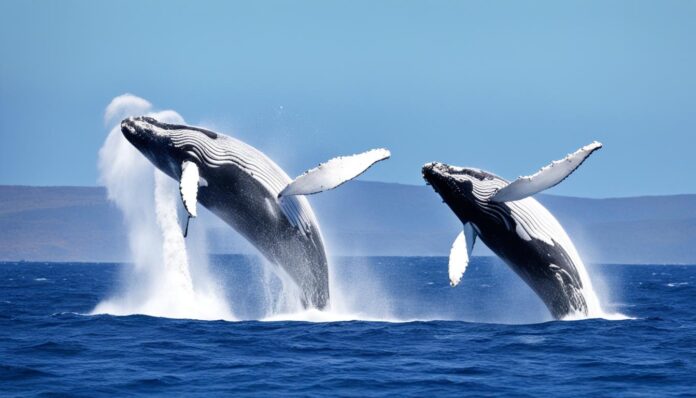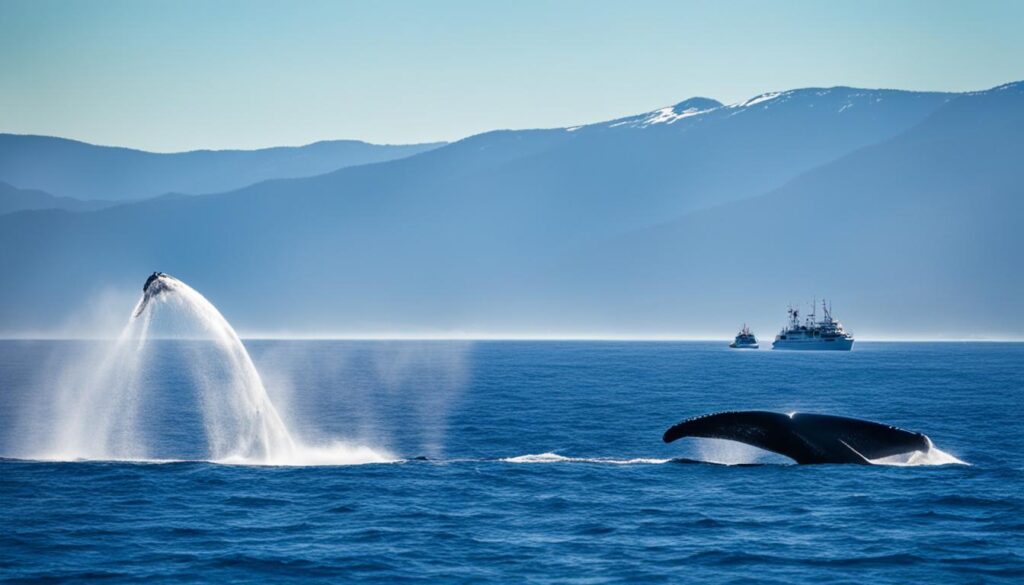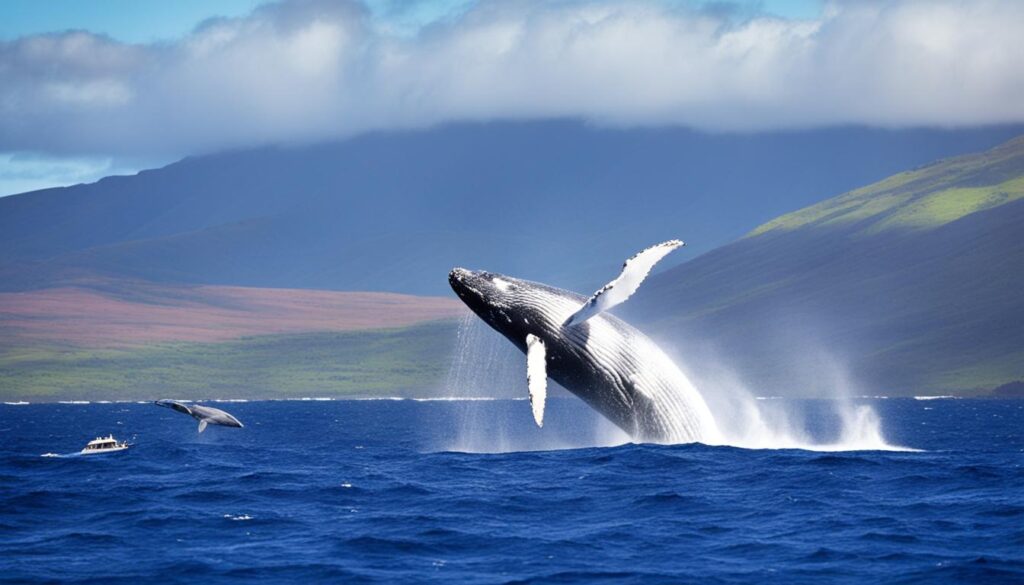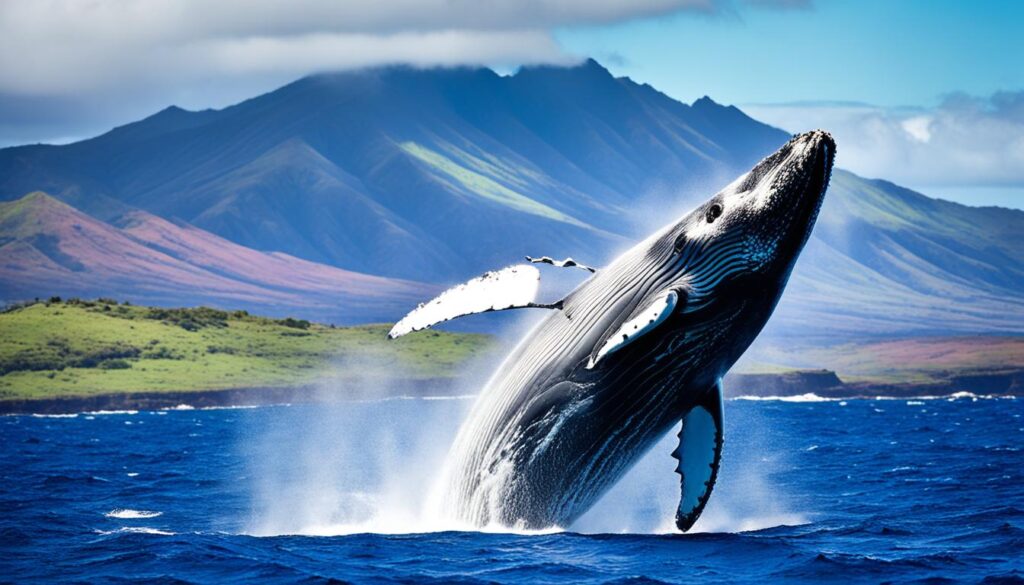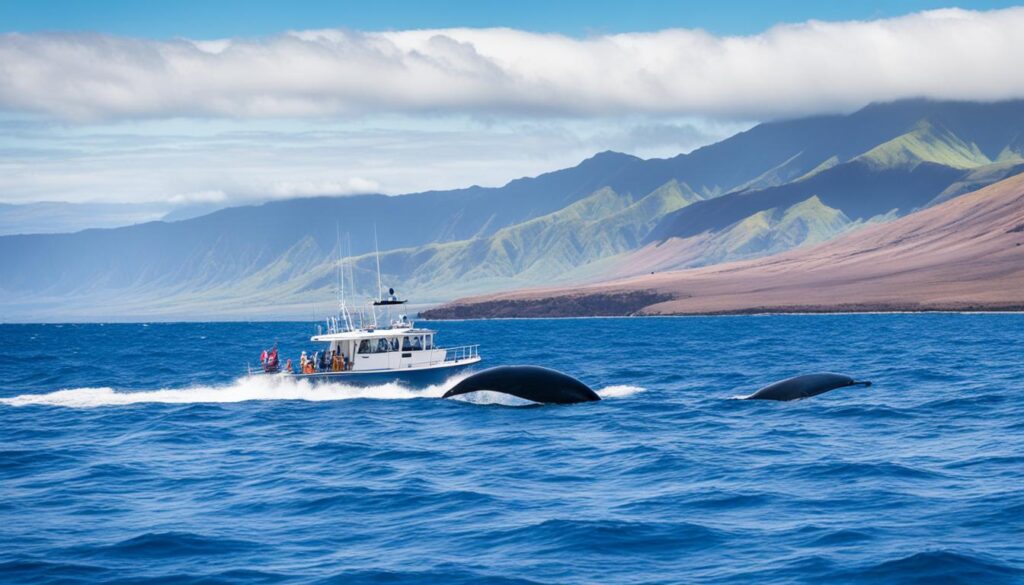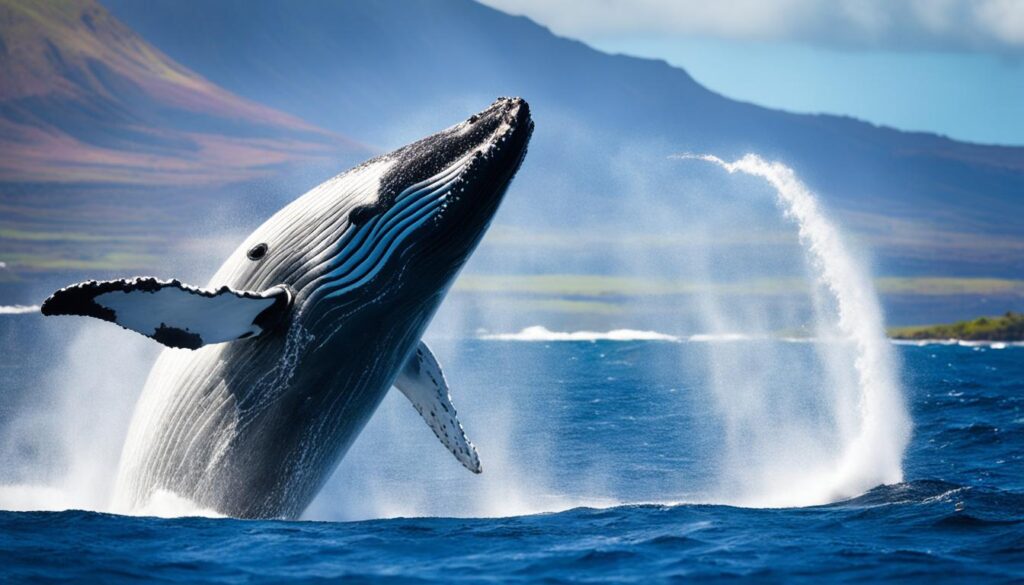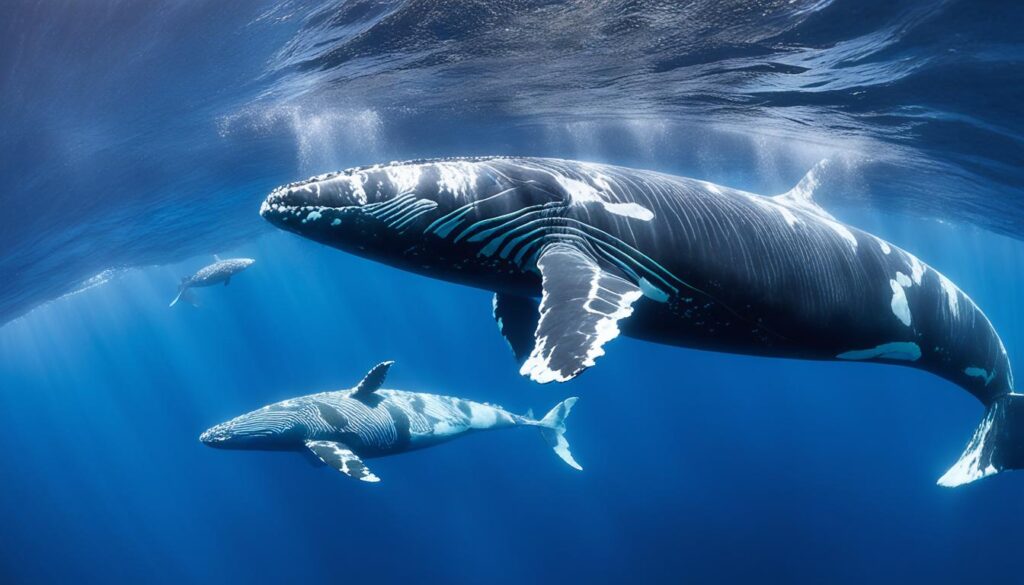Have you ever wondered when is the best time of year to visit Maui for whale watching?
Discover the secret behind the perfect season when humpback whales grace the waters of Maui with their majestic presence.
Prepare to be captivated as we reveal the ideal time to witness these magnificent creatures up close and personal, and unravel the remarkable journey they undertake to make Maui their temporary home.
Get ready to dive deep into the world of whale watching in Maui and uncover everything you need to know about planning your perfect trip, capturing memorable moments, and understanding the significance of whale conservation. It’s time to embark on an unforgettable adventure in the best whale watching season in Maui!
Curious to know more? Let’s explore the wonders of the Maui whale watching season together!
Witness Majestic Humpbacks Up Close
Are you ready for an extraordinary encounter with the mighty humpback whales in their natural habitat? Maui offers the perfect opportunity to witness these majestic creatures up close and personal.
Known for their impressive size and captivating behaviors, humpback whales migrate to the warm waters of Maui each year, creating a spectacle that leaves visitors in awe. When planning your whale watching adventure, it’s essential to understand the best time to see these magnificent creatures in action.
The best time to go whale watching in Maui is during the winter months, typically from mid-December to early April. This is when thousands of humpback whales make their journey from the icy Alaskan waters to the tropical breeding grounds of Hawaii.
During this time, you can witness thrilling displays of breachings, tail slaps, and mesmerizing songs as the male humpbacks compete for the attention of the females. With luck, you may even spot a newborn calf learning its first moves from its nurturing mother.
To give you a better understanding of the ideal time for whale watching in Maui, here’s a table highlighting the peak sightings month by month:
| Month | Peak Sightings |
|---|---|
| December | High |
| January | High |
| February | High |
| March | High |
| April | Moderate |
| May | Low |
| June | Low |
| July | Low |
| August | Low |
| September | Low |
| October | Low |
| November | Low |
As you can see from the table, the peak sightings occur during the winter months, with December to March offering the highest chances of encountering these magnificent creatures. However, even during the moderate season in April, you still have a good opportunity to witness humpbacks in their natural habitat.
So, mark your calendars and plan your Maui vacation during the best time to see whales in Maui. Prepare to be amazed as you witness the awe-inspiring beauty of humpback whales up close, creating memories that will last a lifetime.
Understanding the Maui Whale Watching Season
Gain a deeper understanding of the Maui whale watching season and discover the months when humpback whales frequent these waters. Learn about the unique behaviors and reasons that attract these gentle giants to Maui’s coast.
Maui Humpback Whale Season
The Maui humpback whale season is a remarkable time when these magnificent creatures migrate from the cold waters of Alaska to the warm tropical waters of Maui. It is during this season that humpback whales engage in mating, calving, and other captivating behaviors.
From November to May, the waters surrounding Maui become a breeding ground and nursery for these awe-inspiring marine mammals. The peak of the breeding season typically occurs from January to March, offering a higher chance of witnessing the remarkable courtship rituals and acrobatic displays of the humpback whales.
“Witnessing the playful nature and majestic presence of these creatures is truly awe-inspiring, and the Maui humpback whale season provides the perfect opportunity to marvel at their beauty.”
Whale Watching Season in Maui
The whale watching season in Maui coincides with the Maui humpback whale season, offering visitors a front-row seat to one of nature’s greatest shows. Embark on a thrilling adventure as you observe the incredible behaviors of humpback whales in their natural habitat.
By aligning your visit with the whale watching season in Maui, you increase your chances of encountering these gentle giants during their migration. Professional whale watching tours and knowledgeable guides are available to provide insights into the biology, behaviors, and conservation efforts surrounding these magnificent creatures.
Don’t miss the opportunity to witness breaches, tail slaps, and songs that echo through the ocean waters. The experience of whale watching in Maui is not only educational but also deeply moving, creating memories that will last a lifetime.
| Months | Notable Events |
|---|---|
| November – December | The start of the Maui humpback whale season, with the arrival of the first whales from Alaska. |
| January – March | The peak of the Maui whale watching season, offering the greatest opportunities for witnessing courtship rituals and acrobatic displays. |
| April – May | Whales can still be spotted as the season comes to an end, with some late calves seen swimming alongside their mothers. |
Planning Your Perfect Trip
When it comes to planning your unforgettable whale watching trip in Maui, it’s essential to have the right tips and knowledge in your arsenal. By following these expert tips, you’ll increase your chances of spotting these incredible creatures and ensure a truly memorable experience.
Choose the Right Tour
One of the most important decisions you’ll make is selecting the right whale watching tour. Look for reputable companies that have experienced guides and a strong track record of successful whale sightings. Consider factors such as the size of the boat, the duration of the tour, and the number of passengers to ensure a comfortable and enjoyable outing.
Timing is Key
Timing is everything when it comes to whale watching in Maui. The peak season for humpback whale sightings is from December to April, with February and March being the prime months. Try to plan your trip during this period to maximize your chances of witnessing these majestic creatures up close.
Find the Best Spots
To make the most of your whale watching adventure, it’s important to know the best spots to position yourself for optimal views. Some popular locations include Lahaina Harbor, Maalaea Harbor, and the coastal areas of Kihei and Wailea. Be sure to check with your tour operator for their recommended spots based on current whale activity.
Come Prepared
Ensure you come fully prepared for your whale watching trip. Here are a few essentials:
- Binoculars: Enhance your viewing experience by bringing a pair of binoculars to get a closer look at the whales.
- Sunscreen: Protect your skin from the strong Hawaiian sun with a high SPF sunscreen.
- Extra Layers: The weather can change quickly, so it’s a good idea to layer up with a light jacket or sweater.
- Camera: Capture those incredible moments on camera to cherish for years to come.
- Snacks and Water: Stay hydrated and energized during your tour with snacks and water.
Respect the Whales
While it’s exhilarating to encounter humpback whales, it’s crucial to remember that they are wild animals occupying their natural habitat. Keep a safe distance from the whales and follow the guidance of your tour guides to ensure the well-being of these magnificent creatures.
By following these Maui whale watching tips, you’ll be well-prepared for an extraordinary adventure. Get ready to witness the awe-inspiring beauty of humpback whales in Maui’s pristine waters.
| Tip | Details |
|---|---|
| Choose the Right Tour | Opt for reputable tour operators with experienced guides and a proven track record of successful whale sightings. |
| Timing is Key | Plan your trip during the peak whale watching season from December to April, with February and March being the prime months. |
| Find the Best Spots | Position yourself in popular locations such as Lahaina Harbor, Maalaea Harbor, Kihei, and Wailea for the best chances of catching a glimpse of these magnificent creatures. |
| Come Prepared | Bring binoculars, sunscreen, extra layers, a camera, and snacks and water to enhance your comfort and enjoyment during the tour. |
| Respect the Whales | Maintain a safe distance and follow the guidance of your tour guides to ensure the well-being of the whales and their natural environment. |
Best Months for Whale Watching in Maui
When planning your whale watching adventure in Maui, timing is everything. To ensure you have the best chance of encountering humpback whales during their annual migration, it’s essential to visit during the peak season. The best months for whale watching in Maui are generally considered to be January through March, although sightings can occur as early as November and as late as May.
During these months, thousands of humpback whales make their way to the warm waters surrounding Maui to breed and give birth. This influx of whales creates an incredible spectacle, providing visitors with an unforgettable experience.
- January: The beginning of the peak season, January offers excellent opportunities to witness the courtship displays of male humpback whales as they compete for the attention of females.
- February: As the peak of the season, February is the best time to see mother whales with their calves. Watch in awe as these gentle giants teach their young how to breach and tail slap.
- March: While the season starts to wind down in March, it remains an incredible time to see humpback whales in Maui. Enjoy the last few weeks of their majestic displays before they start their journey back to colder waters.
The Best Time of Day
To maximize your chance of encountering these magnificent creatures, it is recommended to embark on your whale watching excursion during the morning hours or mid-afternoon. The tranquility of these periods allows for optimal visibility and quieter whale behavior, enhancing your overall experience.
| Month | Whale Activity |
|---|---|
| November | Early arrivals; sightings may be less frequent. |
| December | Increased number of whales; courtship displays begin. |
| January | Peak season with active courtship displays. |
| February | Mother and calf interactions; breaching and tail slapping. |
| March | Whales start to move back to colder waters; final displays. |
| April | Some remaining sightings; season winding down. |
| May | Last chance for sightings before the whales depart completely. |
Keep in mind that while these months offer the best chances of seeing humpback whales in Maui, nature is unpredictable, and sightings cannot be guaranteed. However, during the peak season, the chances of encountering these magnificent creatures are significantly higher.
The Journey of Humpback Whales to Maui
Experience the awe-inspiring journey of humpback whales as they make their way to the beautiful waters of Maui during the Maui humpback whale season. These magnificent creatures embark on an epic migration spanning thousands of miles, travelling from their feeding grounds in Alaska to the warm and welcoming waters of Hawaii.
Each year, between November and May, an estimated 10,000 humpback whales navigate through the vast Pacific Ocean, guided by their natural instincts and the pull of Maui’s pristine coast. This incredible migration takes place during the winter months when the cold Alaskan waters become too harsh for their survival, prompting them to seek refuge in the tropical paradise of Hawaii.
The journey begins as the whales gather in Alaska, where they spend the summer months feasting on abundant krill and small fish. As the days grow shorter and the temperature drops, they instinctively know it’s time to leave in search of warmer breeding grounds. With the onset of the Maui humpback whale season, these gentle giants set off on a true marvel of nature.
“To witness the long and arduous journey of humpback whales to Maui is an unforgettable experience. The dedication and perseverance displayed by these magnificent creatures is a testament to their resilience and the importance of preserving their natural habitat.”
During the migration, humpback whales cover vast distances, often swimming for weeks without rest. They face numerous hazards, including predators and the possibility of getting entangled in fishing gear. However, they press on, driven by the instinctual need to reach the warm, sheltered waters of Maui where they will mate, calve, and nurse their young.
The significance of Maui during the breeding season cannot be understated. The sheltered bays and channels provide a safe haven for humpback whales, offering protection from predators and ample food for the growing calves. Maui’s coastal waters become a sanctuary where these majestic creatures carry on the cycle of life, giving birth and nurturing their young.
It’s an honor to witness the arrival of these magnificent creatures during the Maui humpback whale season. Their journey unfolds before your eyes, captivating and inspiring visitors from around the world. Whether you catch a glimpse of a playful breach or witness a nurturing mother and her calf, the experience of seeing humpback whales in Maui is truly unforgettable.
| Journey Highlights | |
|---|---|
| Longest annual mammalian migration | Approximately 3,000-5,000 miles |
| Breaching displays | Impressive leaps out of the water |
| Singing | Unique vocalizations used for communication |
| Mating and calving | Nurturing new generations |
| Social behaviors | Admire their interactions and playful nature |
Spectacular Whale Behaviors in Maui
When you embark on a whale watching excursion in Maui, you’re in for a treat. Witnessing the spectacular behaviors of humpback whales will leave you in awe. These gentle giants showcase their incredible agility and power, putting on breathtaking displays for lucky onlookers.
One of the most captivating behaviors you may witness is breaching. Picture a humpback whale propelling its massive body out of the water and crashing back down with a resounding splash. This breathtaking sight is often accompanied by the distinct sound of the whale’s powerful tail hitting the ocean’s surface. Breaching is not only a mesmerizing spectacle but also serves as a way for whales to communicate, attract mates, or simply have fun.
Another awe-inspiring behavior is tail slapping, also known as lobtailing. Humpback whales use their elongated tails to create a dramatic splash by repeatedly lifting them out of the water and forcefully slapping them against the surface. This behavior can be heard from a distance and is believed to have various meanings, including signaling distress, establishing territory, or possibly attracting attention from other whales.
Furthermore, spy hopping is a behavior that will leave you captivated. Imagine a humpback whale raising its head vertically out of the water, allowing its eyes to peer above the surface. This action gives the whale a better view of its surroundings, enabling it to gather information or simply satisfy its curiosity.
One extraordinary behavior to watch for is the fluke-up dive. As a humpback whale prepares for a deep dive, its massive tail emerges from the water, displaying the distinct pattern on its underside known as a fluke. The sighting of a fluke-up dive is not only visually stunning but also an indication of the whale’s descent into the ocean’s depths for feeding or resting.
These remarkable behaviors are just a glimpse of the captivating encounters you can have during the Maui whale watching season. Every moment spent on the waters surrounding this beautiful island holds the potential for witnessing nature’s true marvels.
| Behavior | Description |
|---|---|
| Breaching | A humpback whale propels its body out of the water and crashes back down, creating a spectacular splash. |
| Tail Slapping | The whale lifts its tail out of the water and forcefully slaps it against the surface, making a resounding sound. |
| Spy Hopping | The whale raises its head vertically out of the water to observe its surroundings. |
| Fluke-Up Dive | The whale’s tail emerges from the water, displaying the distinct pattern on its underside before diving deep. |
Choosing the Right Whale Watching Tour
When planning your Maui whale watching adventure, selecting the right tour is crucial to ensure an unforgettable experience. With numerous options available, it’s essential to choose a tour that offers the best chances of sightings, knowledgeable guides, and a comfortable and safe journey. Here are some insider tips to help you make the right choice:
- Research tour companies: Before booking a whale watching tour, take the time to research different companies and compare their offerings. Look for reputable companies with experienced captains and naturalist guides who can provide valuable insights into the behavior and habitat of humpback whales.
- Read reviews: Online reviews and customer testimonials can give you a deeper understanding of what to expect from a particular tour. Pay attention to feedback regarding the quality of the sightings, the expertise of the guides, and the overall customer experience.
- Consider the boat: The type and size of the boat can significantly impact your whale watching experience. Smaller boats or catamarans often provide a more intimate and personalized experience, allowing you to get closer to the whales. Larger vessels may offer more amenities and stability, particularly for those prone to seasickness.
- Duration of the tour: While some tours may last a few hours, others offer half-day or full-day excursions. Consider your preferences and schedule when selecting the duration of the tour. Longer tours often provide more opportunities for sightings and a more comprehensive whale watching experience.
- Check for guarantees: Look for tour operators that offer guarantees or policies regarding whale sightings. While it’s impossible to predict nature, some companies may offer a bonus trip or refund if no whales are spotted during your tour.
“Choosing the right whale watching tour can make all the difference in your Maui adventure. Opting for a knowledgeable guide and a tour company with a track record of successful sightings will increase your chances of witnessing the incredible beauty of humpback whales.”
Remember, the best time to see whales in Maui is during the peak season, which typically runs from December to April. During this time, humpback whales migrate from Alaska to the warm waters of Maui to breed and give birth. Selecting a tour during this period will maximize your chances of encountering these magnificent creatures.
Now that you have some essential tips for choosing the right whale watching tour in Maui, let’s explore the specific months considered the best for whale watching in Maui in the next section.
| Tour Company | Type of Boat | Duration | Price |
|---|---|---|---|
| Pacific Whale Foundation | Catamaran | 2.5 hours | $79 |
| Ultimate Whale Watch & Snorkel | Small Boat | 3 hours | $89 |
| Maui Adventure Cruises | Large Vessel | 5 hours | $149 |
| Maui Whale Watching Eco-Adventures | Small Boat | 4 hours | $119 |
Capturing Memorable Moments
During your unforgettable whale watching experience in Maui, you’ll undoubtedly want to capture the breathtaking moments that unfold before your eyes. With the right equipment, composition, and techniques, you can preserve these memories for a lifetime.
Tips for Equipment
When it comes to photographing or filming humpback whales, having the right equipment is essential. Here are some tips to ensure you’re prepared:
- Invest in a high-quality DSLR camera or a marine-grade waterproof action camera to capture stunning images and videos.
- Use a telephoto lens with a long focal length to zoom in on the whales and capture intimate details.
- Consider using a tripod or image stabilization feature to steady your shots, especially on a moving boat.
Composition Techniques
Composition plays a crucial role in creating visually striking photographs and videos. Keep these tips in mind:
- Utilize the rule of thirds by placing the subject (whale) off-center, creating a more dynamic composition.
- Include elements of the surrounding environment, such as the ocean or the scenic coastline, to add context and depth to your shots.
- Experiment with different angles and perspectives to capture unique and compelling images.
Techniques for Whale Watching Photography and Videography
Whale watching photography and videography require patience and skill. Here are some techniques to help you capture those once-in-a-lifetime moments:
- Anticipate whale behaviors and be ready to click or record at the right moment.
- Keep the horizon level in your shots to maintain a balanced composition.
- Adjust your camera settings to accommodate the lighting conditions, such as using a faster shutter speed for action shots.
- If shooting video, avoid excessive zooming and panning to prevent shaky footage.
Remember, whenever you’re observing these magnificent creatures, prioritize their safety and comfort. Maintain a respectful distance and follow the guidelines provided by your tour operator to ensure minimal disturbance to the whales and their natural habitat.
“Photography is a way of feeling, of touching, of loving. What you have caught on film is captured forever… It remembers little things long after you have forgotten everything.” – Aaron Siskind
Memories to Treasure
With the right equipment, composition techniques, and shooting skills, you’ll be able to capture stunning photographs and videos of humpback whales during your Maui adventure. These timeless memories will serve as reminders of the awe-inspiring moments you witnessed and allow you to share the beauty of these magnificent creatures with others.
| Recommended Equipment for Whale Watching Photography and Videography | |
|---|---|
| Camera | DSLR or waterproof action camera |
| Lens | Telephoto lens with a long focal length |
| Stabilization | Tripod or image stabilization feature |
Other Exciting Activities in Maui
While whale watching in Maui is an incredible experience, there’s more to discover beyond the majestic humpback whales. Enhance your Maui adventure with these thrilling activities and attractions:
- Explore Scenic Coastal Areas: Immerse yourself in the beauty of Maui’s coastline by exploring its stunning beaches and hidden gems. From the golden sands of Ka’anapali Beach to the rugged cliffs of the Road to Hana, the coastal areas offer breathtaking views and opportunities for hiking, snorkeling, and even surfing.
- Experience Local Cuisine: Treat your taste buds to the flavors of Maui with its vibrant culinary scene. Indulge in fresh seafood, tropical fruits, and traditional Hawaiian dishes. Don’t forget to try the famous Hawaiian shave ice and loco moco for a truly authentic experience.
- Visit Haleakala National Park: Embark on a journey to the summit of Haleakala, a dormant volcano that offers panoramic views of the island. Witness a mesmerizing sunrise or go stargazing at this extraordinary location. Don’t forget to pack warm clothing, as temperatures can be chilly at higher elevations.
- Snorkel or Dive in Molokini Crater: Explore one of Hawaii’s top snorkeling and diving spots, Molokini Crater. Located just off the coast of Maui, this crescent-shaped crater is home to an abundance of marine life and crystal-clear waters. Dive into the underwater paradise and witness colorful coral reefs and tropical fish.
- Take a Road Trip on the Road to Hana: Embark on a scenic drive along the famous Road to Hana, a winding road that showcases the island’s natural beauty. Discover breathtaking waterfalls, lush rainforests, and picturesque viewpoints along the way. Don’t forget your camera to capture the unforgettable moments.
“Maui offers an array of exciting activities and attractions to complement your whale watching adventure. Explore the picturesque coastal areas, savor the local cuisine, witness the stunning sunrise from Haleakala, dive into the pristine waters of Molokini Crater, or take a memorable road trip along the Road to Hana. Create unforgettable memories during your time in Maui.”
Make the most of your Maui experience by combining the thrill of whale watching with these extraordinary activities. Whether you’re seeking adventure, natural beauty, or delicious food, Maui has it all.
Insider Tip: Local Guides
For the best recommendations and insights, consider booking tours and excursions with local guides. They have extensive knowledge about the island and can provide valuable information about the best time to see whales, the most scenic spots, and hidden gems that will make your Maui adventure truly special.
Whale Conservation and Preservation
In addition to providing an incredible experience for visitors, whale watching in Maui also plays a vital role in whale conservation and preservation. By understanding the importance of protecting these magnificent creatures and their fragile ecosystem, you can contribute to their well-being and the sustainability of their habitat.
Protecting Maui’s Whales and Their Habitat
Maui’s humpback whales face numerous threats, including entanglement in fishing gear, ship strikes, and the impact of climate change on their food sources. It is crucial to support efforts aimed at minimizing these risks and creating a safe environment for these gentle giants.
One way you can contribute is by choosing responsible whale watching tour operators who prioritize the well-being of the whales. These operators adhere to guidelines that minimize disturbance to the whales, ensuring a respectful and sustainable experience.
Supporting Research and Education
Scientific research plays a crucial role in understanding whale behavior, migration patterns, and the overall health of their populations. By supporting organizations dedicated to whale research and education, you can contribute to the ongoing conservation efforts.
Consider donating to non-profit organizations focused on marine conservation or participating in citizen science programs that collect valuable data on whale sightings and behaviors. Your contribution can help scientists gain insights into the well-being of these magnificent creatures and inform conservation strategies.
Reducing Your Impact
Visiting Maui for whale watching is an exciting opportunity, but it’s important to minimize your impact on the whales and their fragile habitat. Follow these tips to ensure a responsible and eco-friendly experience:
- Observe whales from a safe distance to avoid disturbing their natural behavior. Keep at least 100 yards away from the whales and never approach them head-on.
- Avoid overcrowding. Choose tour operators that limit the number of passengers to minimize the impact on the whales and the marine environment.
- Dispose of waste properly. Help keep Maui’s waters clean by using designated trash and recycling bins.
- Choose reef-safe sunscreens to protect both your skin and the delicate marine ecosystem.
Getting Involved Locally
Become an advocate for whale conservation by getting involved with local organizations dedicated to protecting Maui’s whales. Volunteer your time, participate in beach clean-ups, or attend educational events that raise awareness about the importance of whale preservation.
By actively supporting and engaging in conservation efforts, you can help ensure that future generations will continue to marvel at the beauty and majesty of Maui’s humpback whales.
| Organization | Website |
|---|---|
| Pacific Whale Foundation | www.pacificwhale.org |
| Maui Whale Watching Foundation | www.mauiwhalewatchingfoundation.org |
| NOAA Fisheries | www.fisheries.noaa.gov |
| Maui Ocean Center Marine Institute | www.mocmarineinstitute.org |
Conclusion
Whale watching in Maui offers a truly unforgettable experience. Throughout this article, we have explored the best time to visit Maui for this incredible activity and have delved into the unique behaviors and reasons that attract humpback whales to these waters.
By planning your trip during the optimal whale watching season, you can witness the majestic humpbacks up close and personal, as they breach, tail slap, and display other breathtaking behaviors. Remember to choose the right tour that offers knowledgeable guides to enhance your experience and increase your chances of sightings.
Maui’s whale conservation and preservation efforts highlight the importance of protecting these magnificent creatures and their delicate ecosystem. As you embark on the journey of capturing memorable moments through photographs and videos, ensure you do so responsibly and with respect for the whales and their environment.
When visiting Maui, don’t miss the opportunity to explore other exciting activities and attractions that complement your whale watching adventure. From beautiful coastal areas to delicious local cuisine, there’s no shortage of wonders to discover on your Maui experience. Plan your trip wisely, embrace the wonders of whale watching, and create memories that will last a lifetime.




























